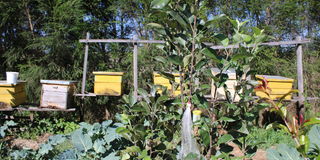A year of mixed fortunes for Nyandarua farmers

A smart climate farm mixing apple farming and beekeeping in dry Ndaragua region, Nyandarua County in this photo taken on December 23, 2024. PHOTOS/WAIKWA MAINA
What you need to know:
- Climate change brought both challenges and opportunities, prompting innovative strategies from farmers and county governments, including diversification into climate-resilient crops
- While some areas suffered, traditionally dry regions in the Ndaragua Constituency experienced an unexpected boost.
- For the first time in years, farms yielded significant crops, with maize intercropped with beans thriving.
Farmers in Nyandarua and Laikipia counties experienced a year of extremes in 2024, with food insecurity experienced in areas once considered food baskets, while traditionally arid regions reported unprecedented yields. Climate change brought both challenges and opportunities, prompting innovative strategies from farmers and county governments, including diversification into climate-resilient crops.
“Even as we blame climate change and vagaries of weather, we must understand that they also present us with new opportunities yet to be exploited. We went for those opportunities guided by historical weather patterns and advice from climate experts,” said Wachira Mugo. Nyandarau’s CEC for Water, Environment and Climate Change
Excessive rains and hailstorms wreaked havoc on farms in Kinangop and Kipipiri Constituencies, Nyandarua’s traditional food baskets. Crops nearing maturity were destroyed, leaving thousands of farmers grappling with losses.
“The hailstorms came when the crop was maturing causing massive losses. Farmers lost everything.. some had taken loans to invest in their farms,” said Nyandarua Agriculture and Livestock Executive Francis Miring’u.
Key crops such as snow peas, a major export, and Irish potatoes were among the hardest hit. In May, a particularly devastating hailstorm in Kirima Village left 3,000 households counting losses as crops were obliterated, livestock killed, and infrastructure damaged.
“That was the first time we experienced such heavy hailstorm lasting two hours,” said Ruth Wambui, a resident. “It started with heavy winds before the rains struck, causing much damage.”
Mercy Ngige, another affected farmer, lost five acres of Irish potatoes valued at Sh500,000. “The potato was doing very well. I expected an early market guaranteeing a minimum of Sh1,000 per bag, but I lost everything,” said Ngige, who had taken a loan to invest in her farm.
To mitigate future losses, the county government partnered with Apollo Agriculture to educate farmers on crop insurance, equipping them to better handle similar challenges.
While some areas suffered, traditionally dry regions in the Ndaragua Constituency experienced an unexpected boost. For the first time in years, some farmers said their farms yielded significant crops, with maize intercropped with beans thriving.
“My three-acre farm yielded 50 bags of maize for the first time. I was about to give up on farming, as prolonged drought always followed the April-May rains. This year, we were lucky,” said Ms Mwihaki Warutumo
Farmers in Ndaragua embraced diverse crops such as cassava and sweet potatoes, which were previously considered unsuitable for the area. The county also promoted commercial sunflower farming and beekeeping as part of climate change adaptation strategies.
“The latest opportunity is apple farming which does well in both dry and wet areas. We distributed apple seedlings worth Sh 26 million and introduced livestock rearing suited to specific areas, alongside dual-purpose fodder crops,” said Agriculture Executive Member Miring’u.
In Laikipia County, regions like Rumuruti, Marmanet and Ol Moran experienced a wheat harvest after years of drought. However, the celebrations were cut short by an invasion of quelea birds that decimated acres of wheat shortly before harvest.
“The bird population keeps growing due to a conducive breeding. We hired young men to chase away the birds, paying them Sh 300 to Sh 500 daily but it didn’t work. I expected to harvest 250 bags from my five-acre farm, but the invasion reduced my yield by almost half,” said farmer Muchendu Muchemi. “
Dan Njau, an official with the Laikipia County Grains Association noted that farmers might abandon wheat farming which could affect wheat flour prices.
“The invasion was a big blow to farmers who rely on wheat farming to sustain their families and educate their children. Diversification might impact the availability and cost of wheat products in the future,” Mr Njau said.



